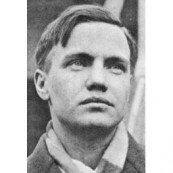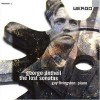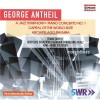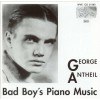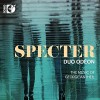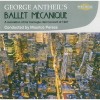传记
George Antheil (/ˈæntaɪl/; July 8, 1900 – February 12, 1959) was an American avant-garde composer, pianist, author and inventor whose modernist musical compositions explored the modern sounds – musical, industrial, mechanical – of the early 20th century.
Spending much of the 1920s in Europe, Antheil returned to the US in the 1930s, and thereafter spent much of his time composing music for films and, eventually, television. As a result of this work, his style became more tonal. A man of diverse interests and talents, Antheil was constantly reinventing himself. He wrote magazine articles (one accurately predicted the development and outcome of World War II), an autobiography, a mystery novel, newspaper and music columns. In 1941 he co-patented a "Secret Communications System" with actress Hedy Lamarr that used a code (stored on a punched paper tape) to synchronise random frequencies, referred to as frequency hopping, with a receiver and transmitter. This technique, which is now known as spread spectrum, is now widely used in telecommunications.
Antheil was born George Johann Carl Antheil, and grew up in a family of German immigrants in Trenton, New Jersey.[1] His father owned a local shoe store in the city.[2][3] Antheil was raised bilingually, writing music, prose, and poetry from an early age, and never formally graduated from high school or college.[3] According to Antheil's autobiography The Bad Boy of Music (1945), he was "so crazy about music", that his mother sent him to the countryside where no pianos were available. Undeterred, George simply arranged for a local music store to deliver a piano.[4] His somewhat unreliable memoir mythologized his origins as a futurist, and emphasized his upbringing near a noisy machine shop and an ominous prison.[2][5] George's younger brother was Henry W. Antheil, Jr. He became a diplomatic courier and died on June 14, 1940, when his plane was shot down over the Baltic Sea.[6]
Antheil started studying the piano at the age of six. In 1916 he traveled regularly to Philadelphia to study under Constantine von Sternberg, a former pupil of Franz Liszt.[3] From Sternberg he received formal composition training in the European tradition, but his trips to the city also exposed him to conceptual art, including Dadaism.[7] In 1919, he began to work with the more progressive Ernest Bloch in New York.[3][7][8] Initially Bloch had been skeptical and had rejected him, describing Antheil's compositions as "empty" and "pretentious"; however, the teacher was won over by Antheil's enthusiasm and energy, and helped him financially as he attempted to complete an aborted first symphony.[3][9] Antheil's trips to New York also permitted him to meet important figures of the modernist movement, including the musicians Leo Ornstein and Paul Rosenfeld, the painter John Marin, photographer Alfred Stieglitz, and Margaret Anderson, editor of the The Little Review.[7]
At age 19, Antheil was invited to spend the weekend with Anderson and a group of friends; he stayed six months, and the close-knit group, who included Georgette Leblanc, former companion of Maurice Maeterlinck, were to become influential in Antheil's career. Anderson described Antheil as short with an oddly shaped nose, who played "a compelling mechanical music", and used "the piano exclusively as an instrument of percussion, making it sound like a xylophone or a cymballo." Intensely engaged in his music, during this period Antheil worked on songs, a piano concerto and a work that came to be known as "the Mechanisms".[10]
Around this time, von Sternberg introduced Antheil to his patron of the next two decades: Mary Louise Curtis Bok, later the founder of the Curtis Institute of Music.[10] Assured by von Sternberg of Antheil's genius and good character, Bok gave him a monthly stipend of $150, and arranged for him to study at the Philadelphia Settlement Music School. Though she came to disapprove of his behavior and his work, for the next twenty years she continued to respond favorably to his letters.[9][10] As her financial support enabled Antheil to maintain a degree of independence in his work, many observers believed he should have given her more credit in his autobiography for the length and extent of her contribution to his career.[11]
Antheil continued his piano studies,[9] and the study of modernist compositions, such as those by Igor Stravinsky and members of the Les Six group of French composers. In 1921, he wrote his first in a series of technology-based works, the solo piano Second Sonata, "The Airplane". Other works in the group included the Sonata Sauvage (1922–3) and subsequently Third Sonata, "Death of Machines" (1923), "Mechanisms" (ca 1923), both composed in Europe.[12] He also worked on his first symphony, managing to attract Leopold Stokowski to premiere it. Before the performance could take place, Antheil left for Europe to pursue his career. This may have diminished his chances for success in his native country.[13]
On May 30, 1922, at the age of 21, Antheil sailed for Europe to make his name as "a new ultra-modern pianist composer" and a "futurist terrible"."[14][15] He had engaged Leo Ornstein's manager, and opened his European career with a concert at Wigmore Hall. The concert featured works by Claude Debussy and Stravinsky, as well as his own compositions.[14]
He spent a year in Berlin, planning to work with Artur Schnabel, and gave concerts in Budapest, Vienna and at the Donaueschingen Festival. As he had desired, he achieved notoriety, but often had to pay the concert expenses out of his own pocket. His financial situation was not helped by Mrs. Bok's reduction of his stipend by 50 percent, though she often responded to requests to fund specific aspects of his concerts.[14] He met Boski Markus, a Hungarian and niece of the Austrian playwright Arthur Schnitzler who became his companion and whom he married in 1925.[16][17]
In the fall of 1922, Antheil took advantage of a chance meeting to introduce himself to his idol Stravinsky in Berlin. They established a warm intimacy and the more established composer encouraged Antheil to move to Paris.[18][19] He went as far as arranging a concert to launch Antheil's career in the French capital, but the younger man failed to show up, preferring to travel to Poland with Markus.[20] The Antheils finally arrived in Paris in June 1923, in time to attend the premiere of Stravinsky's ballet Les Noces, but the relationship with Stravinsky did not survive for long. Stravinsky cut the younger man dead, having discovered that Antheil had boasted that "Stravinsky admired his work". The breach devastated Antheil, and was not ultimately repaired until 1941, when Stravinsky sent the family tickets to a concert he was giving in Hollywood.[2][19]
Despite the inauspicious beginning, Antheil found Paris, at the time a center of musical and artistic innovation, to be a "green tender morning" compared to the "black night" of Berlin.[21] The couple lived in a one bedroom apartment above Sylvia Beach's bookshop Shakespeare and Company.[17][22] Beach described him "as fellow with bangs, a squished nose and a big mouth with a grin in it. A regular American high school boy."[23] She was very supportive, and introduced Antheil to her circle of friends and customers including Erik Satie, Ezra Pound, James Joyce, Virgil Thomson and Ernest Hemingway. Joyce and Pound were soon talking of an opera collaboration.[24] Pound, in particular, was to become an extravagant supporter and promoter of Antheil and his work, comparing him variously to Stravinsky and James Cagney, and describing him as breaking down music to its "musical atom". Pound introduced Antheil to Jean Cocteau who in turn helped launch Antheil into the musical salons of Paris, and commissioned him to write three violin sonatas for his companion, Olga Rudge. In 1924 Pound published Antheil and the Treatise on Harmony, as part of his campaign to boost Antheil's reputation. The book may have done Antheil more harm than good, and the composer was to distance himself from it in his memoir.[25][26][27] Natalie Barney helped produce some original works, including the First String Quartet in 1925.[28]
Antheil was asked to make his Paris debut at the opening of the Ballets suédois, an important Paris social event. He programmed several recent compositions, including the "Airplane Sonata", the "Sonata Sauvage" and "Mechanism". Halfway through his performance a riot broke out, much to Antheil's delight. According to Antheil "People were fighting in the aisles, yelling, clapping, hooting! Pandemonium!... the police entered, and any number of surrealists, society personages, and people of all descriptions were arrested...Paris hadn't had such a good time since the premiere of Stravinsky's Sacre du Printemps.[29] The riot was filmed and may in fact have been engineered, as the Marcel L'Herbier movie L'Inhumaine needed a riot scene set in a concert hall. In the audience were Erik Satie, Darius Milhaud, Man Ray, Pablo Picasso, Jean Cocteau, and Francis Picabia. Antheil was delighted when Satie and Milhaud praised his music.[26][29]
Reactions to his first performances were cool at best. His technique was loud, brazen, and percussive. Critics wrote that he hit the piano rather than played it, and indeed he often injured himself by doing so. As part of his "bad boy" behavior, Antheil provocatively pulled a revolver from his jacket and laid it on the piano
Antheil died of a heart attack in the New York City borough of Manhattan.[50] His legacy included two accomplished students, Henry Brant and Benjamin Lees. He is buried in Riverview Cemetery, in Trenton, New Jersey.
Charles Amirkhanian, director of the Other Minds festival, is the executor of the Antheil estate.[51]





